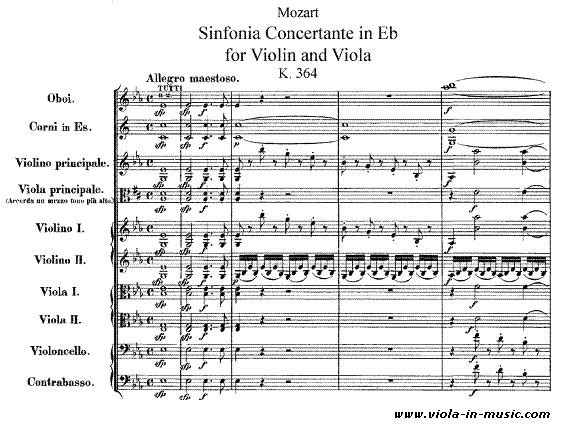|
The musical scoreand a viola related exampleA score is a book containing the music for all instruments required for a piece, written together. In its pages, each line is on top of another one and belongs to a different instrument. So it is quite complicated to read: the conductor has to read it both horizontally, like any other writing, to follow the development of musical phrases, and vertically to see what all instruments do simultaneously at any given time and give the players indications about when to start (very important!) and how to play. Yet, it is very fascinating. In his memoires Hector Berlioz tells about the impression he got when he first saw an orchestral score with twenty-four lines on it. He remembers that "suddenly became aware of the multitude of instrumental and vocal combinations that lay open to an ingenious hand" and that from that moment he was in a state of ever-increasing musical ferment. This is the first page of the score of Mozart's Sinfonia Concertante for violin, viola and orchestra. 
The score tells the conductor or the performers what the composer meant to say with his music, which instruments he wanted, the character of the music, the tempo, whether the music should be played loud or soft and much more. In the above example, Mozart wrote Allegro maestoso. Most musicians think that Allegro means fast but it actually means "cheerful", it's more an indication of character, of mood, rather than an indication of speed or pace. So here the character would be Majestically cheerful. Of course, character and speed are related, but it's important to understand the original meaning of the words used by composers in their works. Otherwise it would be like, for an actor, just reading the words in a play without understanding them, therefore without understanding whether they should need the tone of a tragedy or that of a comedy. The difference between words and music is that music does mean something by itself anyway but, some extra indications help explain the composer's intention and perform the work according to them. Observe that on the left side of the page all instruments playing are listed. Something particular about this score is that Mozart wanted Viola I and Viola II parts in this piace, while most usually in an orchestral piece there is only one viola part. Also, the Viola principale part, after its viola clef, instead of 3 flats (♭♭♭) like all other instruments, as it would be usual, has 2 sharps (♯♯). (Yes, also the Corni, or French horns, part doesn't have flats, but that is normal for them, their part is always written in a different way). This is because in this composition Mozart wanted for the viola a special tuning, the scordatura. So, also from this example you can see that the viola is definitely a distinguished instrument... Go to Mozart's Sinfonia Concertante Go back from Score to Glossary of musical terminology
|
Find what you are looking for,
use this search box



